The Economics and Statistics Division maintains archives of previous publications for accountability purposes, but makes no updates to keep these documents current with the latest data revisions from Statistics Canada. As a result, information in older documents may not be accurate. Please exercise caution when referring to older documents. For the latest information and historical data, please contact the individual listed to the right.
<--- Return to Archive
For additional information relating to this article, please contact:
February 13, 2024BUSINESS COUNTS, DECEMBER 2023 Statistics Canada today released business counts data for December 2023.
The number of business locations in Nova Scotia with employees increased 0.04% between June 2023 and December 2023. Across Canada, business counts increased by 0.12% with gains in all provinces except Newfoundland and Labrador, Québec and Saskatchewan . New Brunswick reported the fastest growth in business counts over this period.

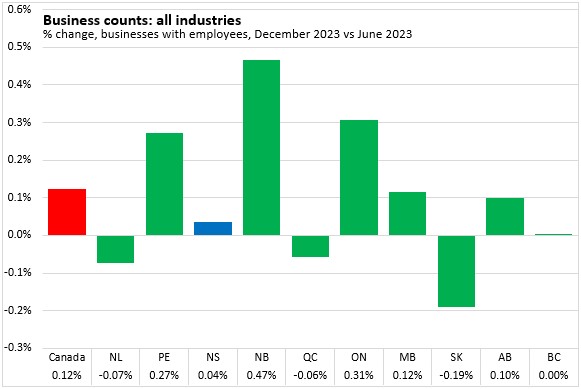
The number of goods producing locations increased 0.1% in Nova Scotia. Nationally, the count of goods producing businesses was up 0.4% with gains in all provinces except Newfoundland and Labrador. Prince Edward Island and New Brunswick reported the fastest growth rates.
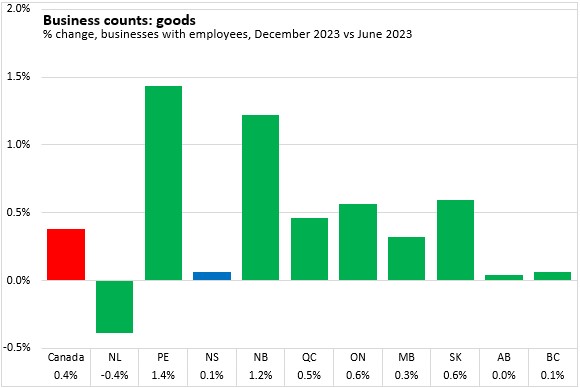
The number of service businesses was also up 0.1% in Nova Scotia - the same pace as growth in goods industries (unclassified businesses were down 0.4%). Nationally the number of service businesses were up 0.1% with declines in six provinces (led by Newfoundland and Labrador and Saskatchewan). Ontario reported the fastest growth in the number of service businesses.
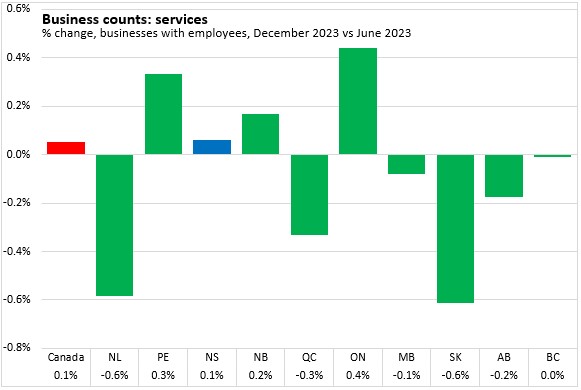
Grouping business counts by employment size, Nova Scotia reported faster growth in the business counts for larger employers (500+ employees) as well as for those that employed between 20 and 49 employees. Business counts were down in Nova Scotia for the smallest businesses (1-4 employees) as well as for enterprises with 50-99 employees and those with 200-499 employees.
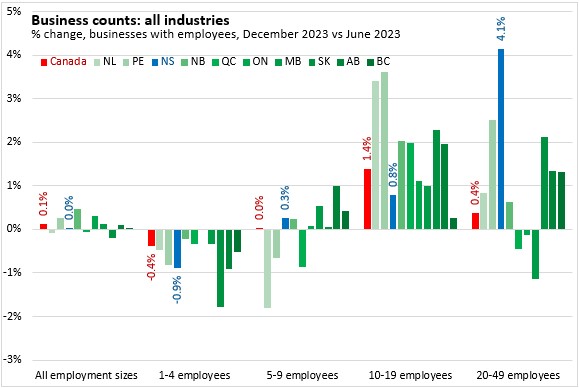
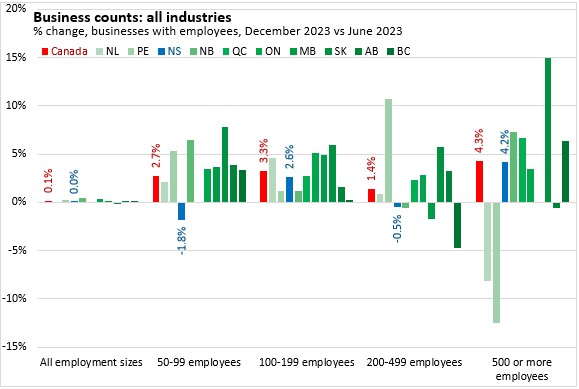
Among industries, the number of public administration businesses reported the largest percentage decline from June to December 2023 (following a large rise in the first half of 2023). Business counts were up most for administrative/business support industries (including call centres) as well as for health/social industries (including daycares) and construction.
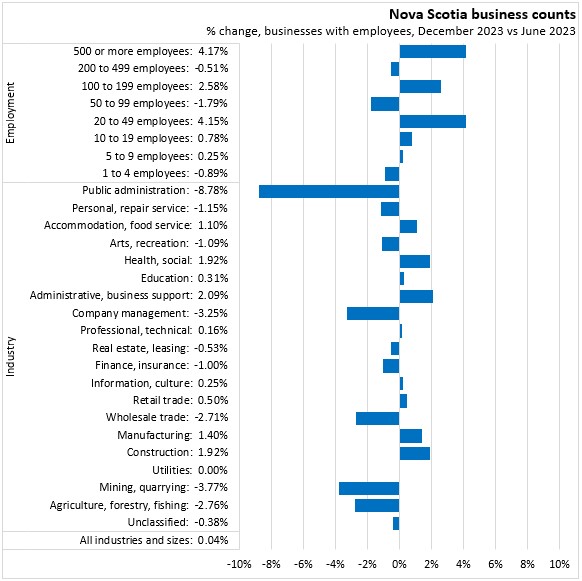
In the Halifax and East Hants Census Metropolitan Area, the business count for large employers was up more than for any other size. Public administration was also the fastest declining business count in Halifax while information/culture, manufacturing and accommodation/food service reported the largest gains.
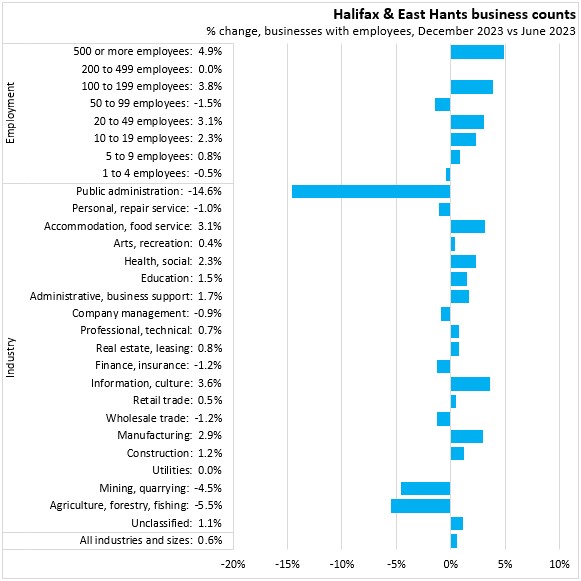
Across Nova Scotia outside Halifax and East Hants, the business count grew fastest for both large employers as well as for employers with 20-49 employees. Most industries reported declining business counts, led by company management (although this is a small industry to begin with). Construction and administrative/support (including call centres) posted the fastest gains in business counts outside Halifax and East Hants.
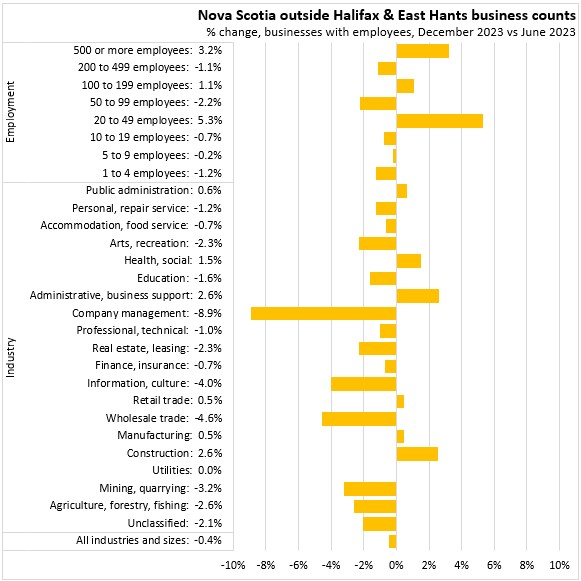
Among Canada's Census Metropolitan Areas (CMA), Halifax and East Hants reported a 0.6% increase in business counts across all industries and sizes. Windsor reported the fastest rise in business counts while Regina posted the steepest decline.
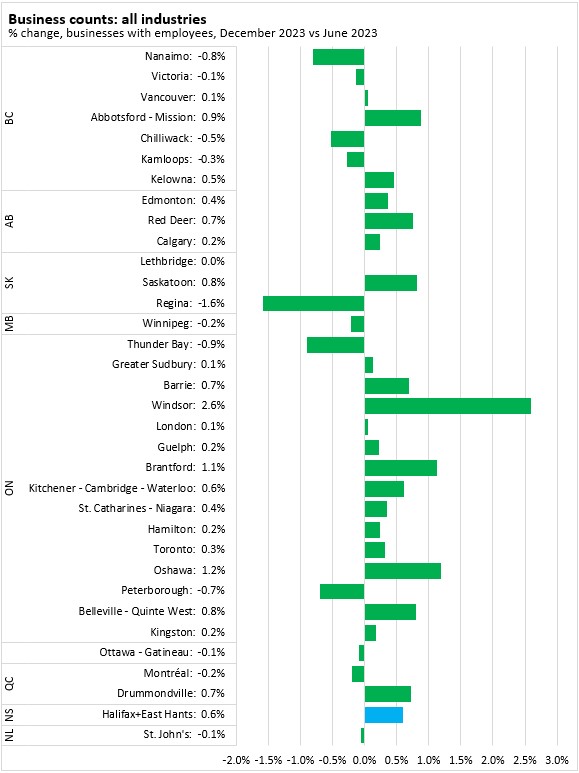
Among Nova Scotia's counties, Digby and Richmond reported the fastest percentage growth in business counts from June 2023 to December 2023. Of the ten counties reporting declining business counts, Annapolis County reported the sharpest decline.
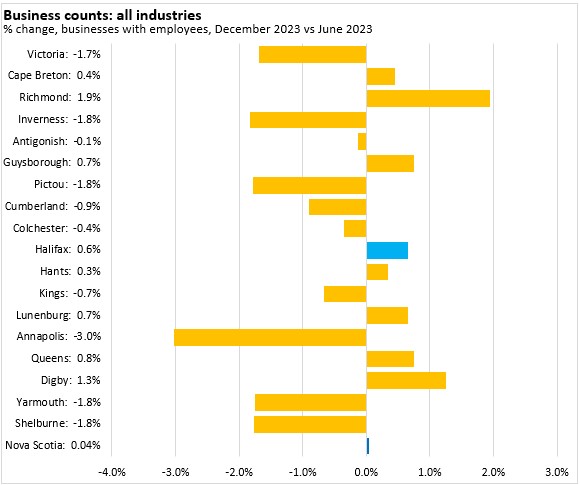
The number of businesses in a particular industry or location is not an indicator of its economic significance; employment, output and income generated are better indicators of economic contributions. However, in addition to growth rates, the relative share of businesses by industry provides some insight on the economic structure of a particular location, relative to other jurisdictions.
Across Canada, businesses in goods industries make up a larger share of all businesses in Saskatchewan and the Maritime provinces. Goods businesses are a lower share of all businesses in Ontario and Newfoundland and Labrador.
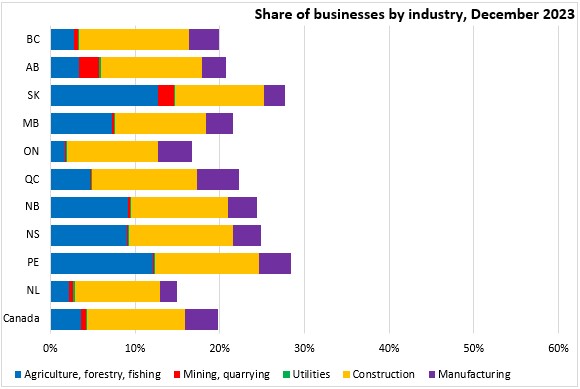
Distribution and personal service industries make up a more consistent share of business counts across the country, with a somewhat higher share in Newfoundland and Labrador as well as in Manitoba.
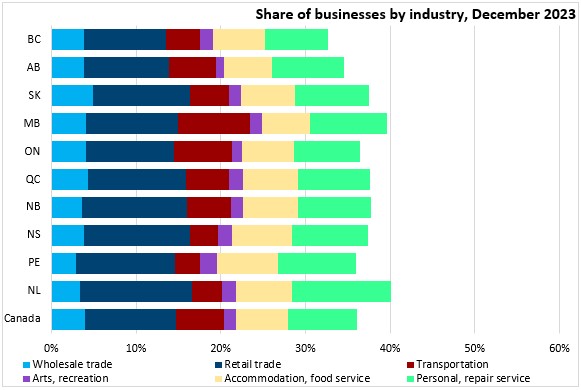
Real estate, finance, professional services, information and culture, company management as well as administrative and business support businesses are notably more concentrated in Canada's four most urban provinces: Ontario, British Columbia, Alberta and Québec.
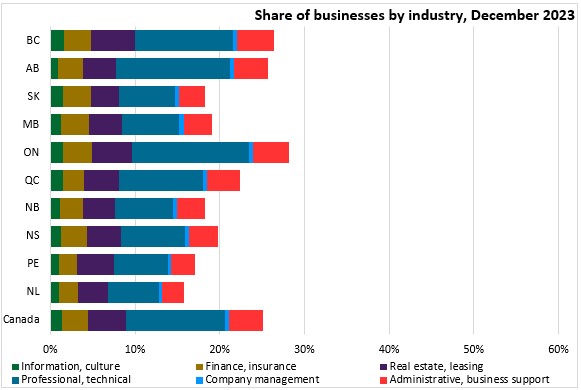
Health, social, education and public administration businesses make up a similar share of business counts across most provinces.
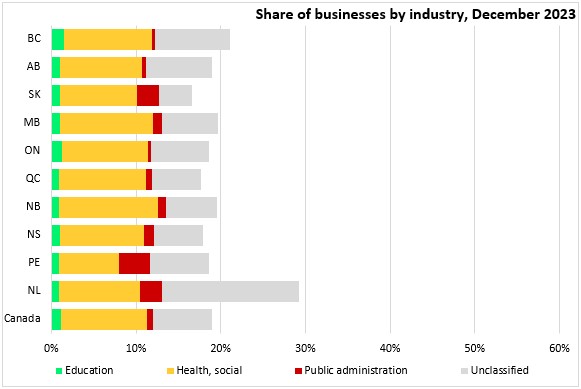
Among Nova Scotia's counties, goods-businesses are a larger share of total business counts in Shelburne, Yarmouth, Digby, Guysborough and Victoria counties (notably from agriculture, forestry and fishing).
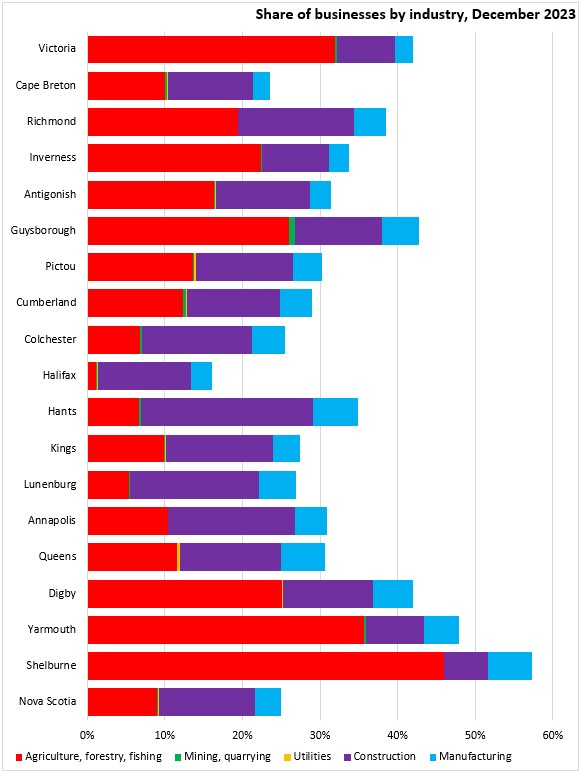
Distributive and personal services businesses are more uniformly distributed across Nova Scotia's counties.
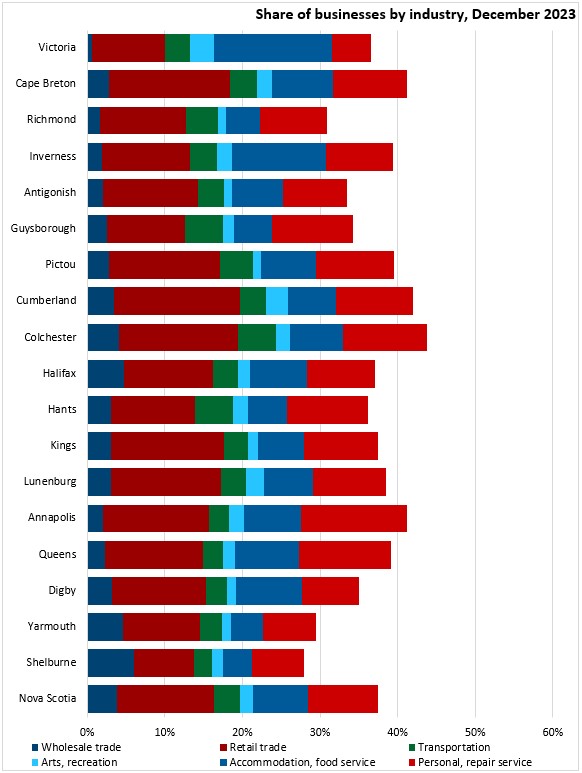
Financial, real estate, professional and administrative services were more concentrated in Halifax - particularly for professional and technical services as well as real estate and leasing.
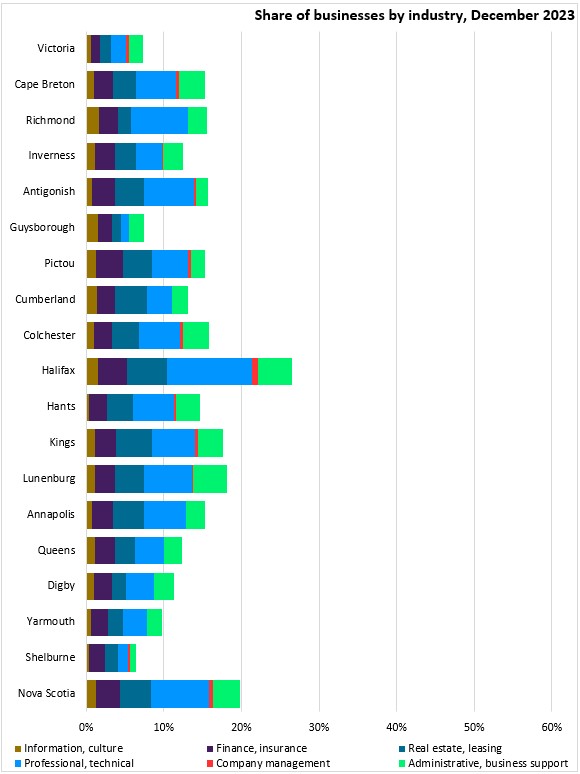
Health, social, education and public administration businesses were larger shares of all businesses in Halifax, Antigonish, Cape Breton, Kings and Queens counties.
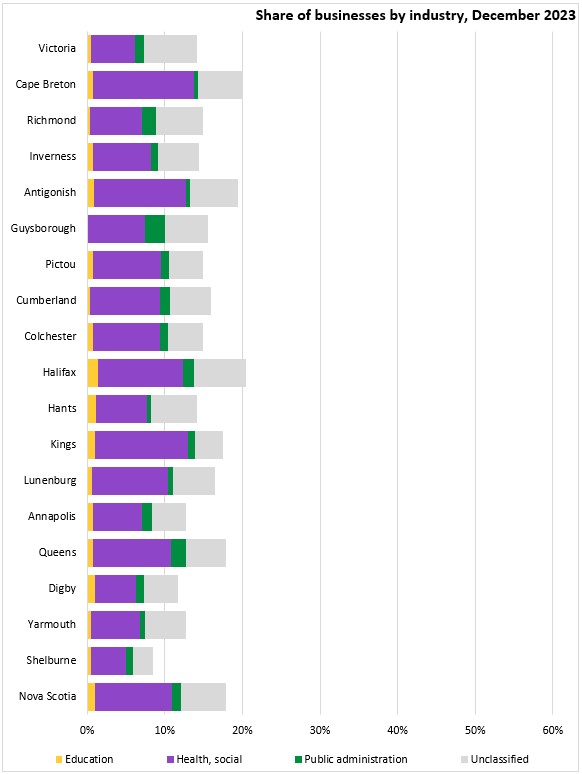
Key definitions for Statistics Canada's Business Register:
Statistical Enterprise
An enterprise is the legal operating entity at the top of the operating structure. There is only one enterprise per operating structure. It is associated with a complete set of financial statements.
Statistical Establishment
A statistical establishment is the production entity or the smallest grouping of production entities which:
- Produces a homogeneous set of goods or services;
- Does not cross provincial boundaries; and
- Provides data on the value of output together with the cost of principal intermediate inputs used along with the cost and quantity of labour resources used to produce the output.
- For example, a plant in the manufacturing industry which provides accounting information regarding the value of shipments (sales), direct costs and labour costs is considered a single establishment. However, two stores in the retail industry may be considered one establishment if the accounting information, described in item (c) above, is not available separately, but is combined at a higher level.
Statistical Location
The location is an operating entity, specifically a production entity which:
- Conducts economic activity at or from a single physical location or group of locations;
- Resides within the smallest standardized geographical area;
- Is able to provide employment data at a minimum.
- Multiple locations can be found under a single enterprise.
Sources: Statistics Canada. Table 33-10-0806-01 Canadian Business Counts, with employees, December 2023; Table 33-10-0808-01 Canadian Business Counts, with employees, census metropolitan areas and census subdivisions, December 2023; Table 33-10-0717-01 Canadian Business Counts, with employees, June 2023;Table 33-10-0719-01 Canadian Business Counts, with employees, census metropolitan areas and census subdivisions, June 2023
<--- Return to Archive